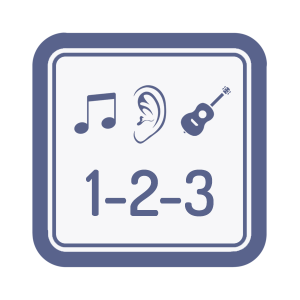
The Play-By-Ear Process
Learn how musicians play by ear using a combination of trial-and-error and specific techniques, and how you can begin playing by ear yourself.
After completing this module: you will understand how to play a song by ear or transcribe it, step-by-step.
Learn the basics of transcription and solfege. Explore specific methods designed to help you play-by-ear.
Module Preview
Contents
- Introduction
- Background: Solfege
- Background: Transcription
- The Process
- Song 1: Someone Like You
- Song 2: More Than Words
- Song 3: Rude
- Conclusion
Here is an excerpt from one lesson of the module:
Introduction
So, we know about how solfège and transcription relate to playing by ear, but we still haven’t really figured out how to play anything by ear just yet. However, now that you are more familiar with how to use your ears to relate notes to one another as well as relating what you hear to what’s on the page, it will be easier to integrate all this into a basic process to playing music by ear.
It should be noted that there’s no fool-proof way of figuring out songs and chord progressions by ear. Sometimes you really do just have to noodle around and try things on your instrument before you can really reproduce the exact sound you are hearing. That being said, most common popular or commercial songs can be easily figured out purely by ear, as you’ll see in the following sections.
The Process
First of all, it is good to start by setting out a clear layout of the song with basic timing indications to help you better understand where the song is going, how many bars you are working with, time signature, etc. This will be your canvas and all you’ll have to do after is to fill out the blanks, which is much easier than to start with a blank page (and probably a sense of nervousness at the idea of not knowing where to start!)
A good choice of second step is to figure out what the bass line is. The bass line will give you a strong sense of the direction of the song and will most likely reflect whatever chord is being played over the bass notes. Naturally this makes it very easy to figure out the chords next. If you have practiced your solfège or can identify intervals quickly, working out the bass line will be a piece of cake, and thus an excellent starting point.
Usually after figuring out the bass line, you will move on to the chord progression. This is because the bassline tends to provide the basis for the chords and the chords tend to provide the basis for the melody.
So once you have the bassline, the chords should follow, and once the chords in place, if you decide to transcribe the main vocal melody or an instrumental parts (maybe you’re trying to learn a song by Chicago and you just can’t get enough of the horn section) it should be very easy to come up with the right notes since they’ll usually fit within the chord, perhaps with a couple of passing tones.
The following examples are varied and comprehensive. The first song we will work on, Someone Like You by Adele, has a simple piano accompaniment with broken chords; the second song, More Than Words by Extreme, features basic chord strumming on the guitar; and finally the last song, Rude by Magic! has a simple chord progression but will help you understand how to deal with a full band when you just want to figure out how to play it by ear by yourself.

